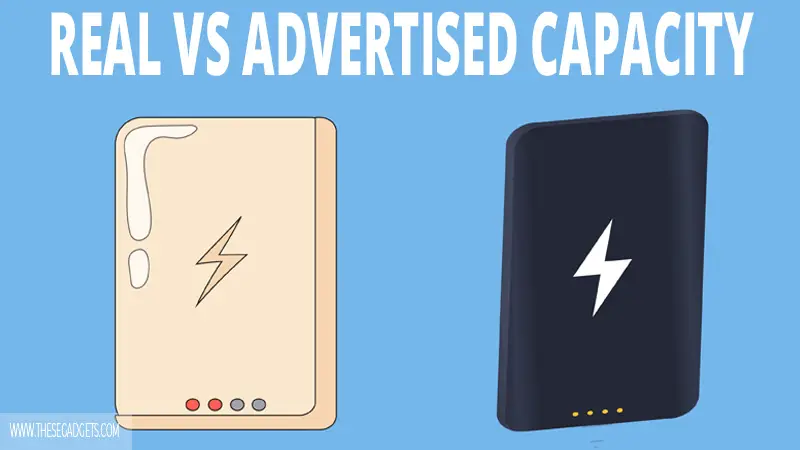If you had a power bank for a long time, you might have noticed that there’s a difference between the rated battery capacity and the real charge transferred to a device.
The rated battery capacity is the capacity of the internal batteries, while the real capacity is the capacity of charge that the power bank is able to transfer.
That may sound confusing but isn’t. This post will explain everything you need to know about the difference between these two, why this happens, and how to calculate the real capacity of a power bank. Let’s dig in.
Contents
Battery Capacity and Voltage Rating
Most power banks have lithium-ion (Li-Ion) or lithium-polymer (Li-Po) batteries and electronic circuits. These batteries use cells with a voltage of 3.7V. There are other types of lithium batteries that come with different voltages such as 3.6V, 3.8V.
The lithium batteries may be made of one cell or multiple cells. If the battery is made of a single cell then the voltage rate will be the same as that cell. If the lithium battery is made of multiple cells then the voltage rate will be based on the configuration that is used to connect cells together. However, most of the times power banks come with lithium batteries of 3.7V.
So, when manufacturers calculate the capacity of a power bank they use a voltage of 3.7V. The rated/advertised battery capacity is based on a voltage of 3.7V. But, the power bank won’t be able to output 100% of its capacity. Here’s why.
Voltage Conversion
The reason why the real capacity of a power bank is different from the rated capacity is the voltage conversion.
Power banks use a USB-C port to charge other devices, these ports have a voltage of 5V and not 3.7V. So, when the 3.7V is converted to 5V the capacity of the power bank drops. To calculate the exact capacity of a power bank with a 5V output, you can use this formula:
Capacity with 5V= 3.7V x (Advertised Capacity) / 5V
Let’s use the same formula for a 10000 mAh power bank:
Capacity with 5V = 3.7V x 10000mAh / 5V = 7400mAh
This formula calculates the real capacity of a power bank at 5V without power loss. But, there will always be power loss when the voltage increases.
Power Loss
The above formula calculates the stored capacity of a power bank at 5V but without power loss. However, the output power of a power bank is always going to be lower than the stored power because of the power loss when the voltage is raised.
The amount of power loss depends on these things:
- The Battery Quality – The quality of the battery is important. If you have a low-quality the power loss will be higher after a few charging cycles. The battery will output less power over time.
- The Electronic Circuit – Because of the voltage conversation, a certain amount of power will be lost in a form of heat. If the electronic circuit is low-quality the amount of power loss will be higher.
- The Battery Age – The more you use a power bank the weaker the battery gets. Old batteries that have surpassed their charging cycles will have a higher power loss than new batteries.
- Storage – The power will be lost in a form of heat. If you are using a power bank in a high-temperature environment then the efficiency rate will drop. That means the power bank will lose more power trying to convert the voltage. It’s best to use a power bank in a cool temperature area.
Therefore, the real battery capacity depends on the quality of your power bank. The better the power bank, the less power is lost during the voltage conversation, this is also called efficiency rating.
The higher the efficiency rate the better. The average efficiency rate of a power bank is 85%. High-quality power banks have a higher efficiency rate than 85%, while low-quality ones have a lower efficiency rate than 85%.
How to Calculate the Actual Capacity?
We have seen that the actual capacity of a power bank depends on the voltage conversion and efficiency rate. So, here’s a formula to calculate the real capacity of a power bank:
Actual capacity = 3.7V x Advertised Capacity x efficiency Rate / 5V
Let’s take a 10000mAh power bank and see its real capacity with a 85% efficiency rate:
Actual Capacity = 3.7V x 10000mAh x 0.85 / 5V = 6882mAh
So, a 10000mAh power bank that has an efficiency rate of 85% has an actual capacity of 8705mAh. 1295mAh has been lost during the voltage conversion and heat.
If you want more methods, check our post on how to calculate the real capacity of a power bank.
What Does Rated Capacity Mean?
Most power banks don’t come with a rated capacity. But, some manufacturers are starting to include it. So, what does it mean?
The rated capacity means that the power bank will be able to at least supply the rated capacity when using one or more USB ports.
So, if a 10000mAh power bank comes with a rated capacity of 6000mAh, it means that it will be able to at least supply 6000mAh.
Final Words
As you can see, the real capacity of the power bank depends on a lot of things. Manufacturers won’t be able to know the real capacity of a power bank so instead, they show only the internal battery capacity.
